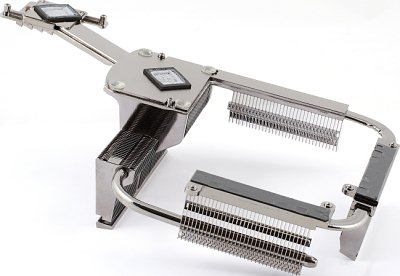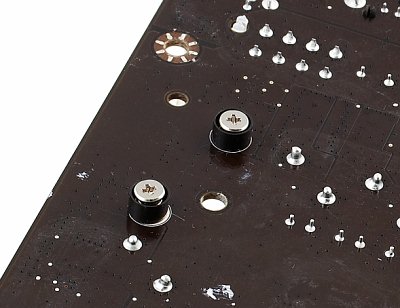XFX nForce 790i Ultra 3-Way SLI and Zotac nForce 790i-Supreme
|
We decided it would be logical to merge reviews of XFX nForce 790i Ultra 3-Way SLI and Zotac nForce 790i-Supreme into one article, because both products are, in fact, reference boards that were ordered by NVIDIA from its manufacturer. Thus, if you are going to buy something similar from another company (e.g. EVGA), this article will also be useful. In fact, two boards we review today differ only by bundles, which we'll describe separately. And the article will be illustrated with photos of the XFX board.

The board has a black-and-green design, typical of reference NVIDIA boards, and comes with a usual set of top features from this company. There are no major flaws in the PCB layout to interfere with the installation, but it's not ideal: we don't like the arrangement of chipset SATA ports (except for two ports installed as a single block lying on its side), CPU power connector, and connectors along the left side of the board. However, expansion slots give most grief: the number of PCIEx16 slots can be explained (motherboard positioning), but there are only two PCI slots, and SLI will block one of them. That's apparently not enough. The chipset cooling system is another story.

It's a very hot chipset, so much effort is put into cooling: along with heat sinks on both bridges (the Southbridge heat sink is tiny, though), the motherboard has three more of them, connected with heat pipes. Moreover, the bundle includes a fan for the Northbridge heat sink, even though NVIDIA does not consider it a mandatory element. It's easy to install, and we recommend that you do it. By the way, the fan sucks the air in through fins of the heat sink instead of pumping it out (it can be attached to the heat sink only one way), thus reinforcing the airflow from a CPU cooler. This assembly consisting of several heat sinks limits your choice of CPU coolers, because not all of them can fit physically into the free space. But most of them will have enough room. Besides, the cooling system of the chipset is attached to the board with sterling screws on the back side instead of plastic latches (it's the first time that we see this approach). Thus, if you want to replace or add thermal grease under the heat sinks (or probably to replace the stock cooling system), you won't have to fight plastic latches, which can live though only a couple of install/remove cycles. Besides, screws allow to increase the pressing force of the heat sink to the chips. Just don't overdo it.

The 6-phase switching voltage regulator of the processor incorporates two field-effect transistors per channel, seven 1000 uF capacitors from United Chemi-Con, eight polymeric SEPC-series capacitors (820 uF) from Sanyo, and several capacitors of lower capacitance. The power system for memory uses several inductive elements and capacitors, mostly from Samxon. We cannot say that capacitors for critical power circuits were selected negligently (or the manufacturer uses capacitors of doubtful provenance). But modern top solutions can usually boast of high-quality polymeric capacitors made in Japan. This reference board from NVIDIA loses the chance to join the loud statements. Motherboard dimensions - 305x245 mm (full-size ATX), ten-screw mount, all edges of the motherboard are fixed.
For obvious reasons, we do not expect XFX to launch new motherboards on nForce 790i Ultra SLI (although EVGA may launch identical products, different in bundles and warranties only). At the same time, there is still some chance left to see the same motherboard on nForce 790i SLI, if the company sees it economically effective.
Write a comment below. No registration needed!
|
|
 |
|
|
|

